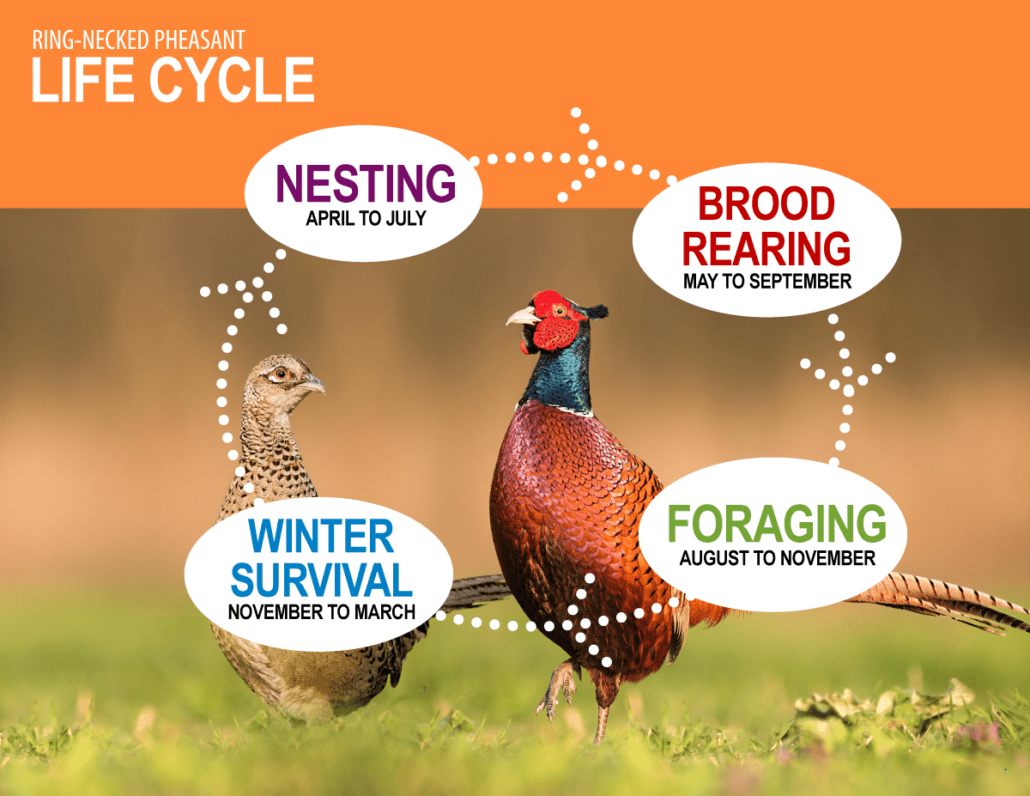The annual life cycle of a pheasant can be broken into four major phases (nesting, brood rearing, foraging and winter survival) that roughly correlate with the seasons (Spring, Summer, Fall and Winter). During each phase the pheasant faces different challenges.
Nesting
The nesting season begins with courtship as roosters scatter from winter cover to establish territories. Hens, attracted by crowing, locate roosters, and if they can find good nesting cover, begin nest building. Once the nest is built, hens lay 1 egg each day. The average clutch (number of eggs in a nest) is 12, but they may lay up to 18. After all the eggs are laid (the actual number will depend on the energy reserves of the hen and time of year), the hen will begin incubating and only leave the nest 1 or 2 times to feed each day. Twenty-three (23) days after incubation begins, the eggs will hatch. Some nests are destroyed, but pheasants are determinant nesters and will try again. Hatching marks the beginning of the brood rearing season.
Average Nest Initiation Date: May 1 (March 15-July 15)
Average Incubation Start: May 24 (April 1 – August 1)
Average Hatch: June 15 (April 15-Aug 15)
Brood Rearing
All fertile eggs in a nest hatch within 24 hours of one another. Shortly after hatching the hen leads the brood to alfalfa or other fields of forbs that are saturated with grasshoppers and other insects needed in the chick’s diet for rapid growth.
More than 90% of a chick’s diet is insects during the first week and 50% during the first 5 weeks. During the first few weeks the brood will stay relatively close to home (10-20 acres surrounding the nest site), but eventually expand their home range to nearly 70 acres. At 3 weeks the chicks are capable of short (150ft) flights, and by 8 weeks they can sustain adult-like flights.
The hen will remain with the brood through 8-10 weeks, but even under her watchful eye half of the brood will be lost to mortality. By the time the young pheasants reach 16 weeks of age, their plumage is virtually indistinguishable from adults.
Fall Foraging
Pheasants feed heavily in the fall to build up the fat reserves needed to get through winter. Habitat is important for foraging as well as for escape and thermal cover. Pheasants are omnivorous with diets that vary with the season and their location. Pheasants will feed on a wide variety of grains and smaller seeds, fresh green shoots, buds, roots, berries, insects, spiders, earthworms and even snails.
Winter Survival
Winters represent the time of greatest mortality for pheasants. Rarely do pheasants freeze or starve, but often the blanketing snows and frigid temperatures reduce their health or concentrate them in limited habitats where predators are the direct cause of mortality.
Mortality
Rarely if ever does a pheasant die of old age, in fact, the average life span is less than 1 year. The pheasant is a prey species and must face major sources of mortality beginning the day it is laid in the nest as an egg through the day it dies.


